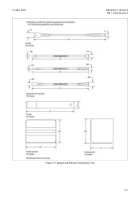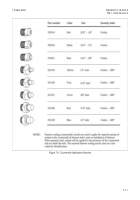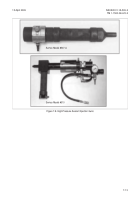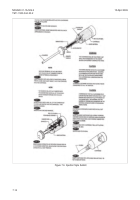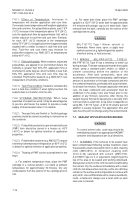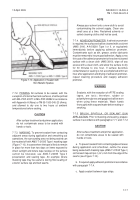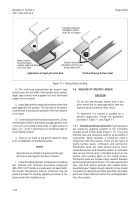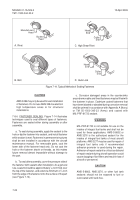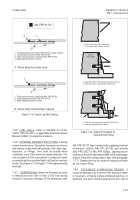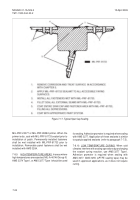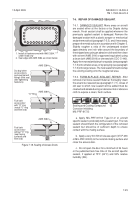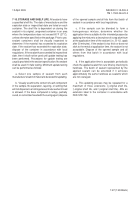TM-1-1500-344-23-2 - Page 134 of 240
7-18
NAVAIR 01-1A-509-2
TM 1-1500-344-23-2
15 April 2009
(1) Paste sealants may be applied with a
nonmetallic spatula or spreader as shown in Figure 7-10.
Avoid the entrapment of air. Work sealant into recesses
by sliding the edge of the spatula firmly back over the
recesses.
Smoothing will be easier if the nonmetallic
spatula is first dipped in water.
(2)
Sealant applied with a brush is applied and
smoothed until the desired thickness is reached.
(3)
Sealant applied with a sealant gun will not
usually require masking and is especially adaptable to
filling seams or the application of form-in-place gaskets.
d. Remove masking tape after the sealant has been
applied and before it becomes tack-free. Cure time will
depend upon the application life of the materials used.
e. If tape residue on these surfaces is excessive,
remove residue using aliphatic naphtha (TT-N-95
Type II) or equivalent.
f. When sealant no longer feels tacky, prime with
MIL-PRF-23377, MIL-PRF-85582 or other primers as
specified. Apply topcoat if specified.
7-7.6. SPRAY GUN APPLICATION. Prior to masking
and sealing, prepare surface in accordance with
paragraphs 7-7.1 and 7-7.2.
CAUTION
After surface treatment and primer application,
do not contaminate areas to be sealed with
hands or tools.
NOTE
The dried film of the spray sealant shall have a
minimum thickness of 6 mils (0.006 inch).
a. Mask off adjacent areas with barrier material
(MIL-PRF-131) held in place with masking tape
(AMS-T-21595 Type I).
Sealing and Coating Compound
12
Corrosion Inhibiting
MIL-PRF-81733
b. Apply MIL-PRF-81733 Type III sealant in a solid,
continuous pattern when spraying over seams whose
configuration is less than 14 inches apart. On seam
connections greater than 14 inches apart, minimize
overspray to adjacent areas.
c. Allow at least four hours for the spray sealant to
dry before subsequent processing.
7-7.7. ePTFE SEALING TAPE (Skyflex™), PEEL AND
STICK APPLICATION. Prior to application, prepare
surface in accordance with paragraphs 7-7.1 and 7-7.2.
CAUTION
After surface treatment and primer application,
do not contaminate areas to be sealed with
hands or tools.
a. Examine faying surfaces to be sealed and build
up any uneven areas on the aircraft frame with
compensation tape (P/N: GSC-21-95158-011 or
equivalent) to create a level faying surface for panel
sealing.
b. Select from Skyflex™ P/Ns: GSC-21-95201-0111,
GSC-21-95241-011, GSC-21-95261-011, GSC-21-98006-
021, GSC-21-95811-022, GUA-1059-1, GUA-1301-1,
or equivalent. The sealant tape should cover the full
width of the faying surface to be sealed.
c. Measure and cut the desired length of ePTFE
sealant tape that is required. Excess tape width should
be trimmed to the width of the faying surface.
d. For corners on aircraft/panels, cut ends of tape at
approximately a 30 degree angle so that the sealant
tape from the converging side will overlap by a minimum
of one quarter to one half inch. The overlap is required
to assure a complete perimeter seal; butt joints are not
acceptable and will allow moisture intrusion and potential
corrosion. Do not fold the tape in corners. This will result
Back to Top


